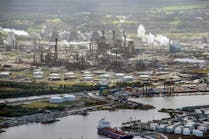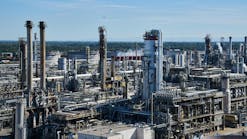Gas projects in the Asia-Pacific region are surging forward.
ARCO Indonesia has disclosed test results from its Vorwata discovery in the Berau block off Irian Jaya. The find bolsters ARCO's plans for a major LNG project there.
Proved plus probable reserves in the field are more than 13 tcf of gas, making it one of the largest gas discoveries in recent years.
Vorwata-1 gas discovery well flowed 30 MMcfd from Jurassic and Permian formations. Vorwata-2 confirmation well-11 miles from the first well-flowed 33 MMcfd, limited by tubing, from more than 400 ft of net pay in Jurassic sandstone. A third well flowed 29 MMcfd of gas.
ARCO and partners have a production-sharing contract with Pertamina for Berau block, which lies about 15 km from Wiriagar gas field.
BG claims an innovation in raising money for its First Gas Power Corp. joint venture to build a $890 million gas-fired power project on Luzon Island, the Philippines.
Financing of $680 million was raised entirely from the private sector, with no government guarantees provided, says BG. The deal marks European Investment Bank's first loan for an Asian independent power project, with funding matched by U.S. private placement investors.
Stephen Brandon, BG's executive director, international downstream operations, said, "The fact that our funding was oversubscribed by a factor of six is a powerful indicator of the confidence (of the financial community)."
The project will take gas from Camago-Malampaya fields off the Philippines, due for development by Royal Dutch/Shell and Occidental, to generate 1,000 MW of electric power beginning late in 1999.
An additional 500 MW of capacity will be brought on line in 2001. Shell and Oxy will supply first gas in January 2002. Before this, the plant will be fueled by condensate supplied by Enron.
First Gas Power is owned 40% by BG, 51% by local company First Philippine Holdings, and 9% by Meralco Pension Fund. The venture was set up to develop gas-related projects in the Philippines.
India plans to tap its coalbed methane potential. The move could help meet expected soaring gas demand there (see related article , p. 37).
The country is estimated to have about 35 tcf of methane from coal sources. If exploited properly, it could back out rocketing oil use, which has surpassed 1.2 million b/d.
India's ONGC has acquired seismic data and drilled two wells to explore for coalbed methane in West Bengal. Additional drilling is planned in other regions.
In Singapore, 2 years of stagnant LPG demand are causing concern that introduction of natural gas may erase the 120,000 metric ton/year, 40-year-old local market for household LPG.
The government has begun studies into the use of natural gas by industry, and refiners are concerned that a natural gas residential market is not far off.
Singapore's four refineries produce an estimated 500,000 tons/year of LPG, 380,000 tons of which are exported to other Southeast Asian countries.
Colombia is lamenting a sharp decline in its upstream operations.
High-risk terrain, minor fields in proven areas, and zones where gas may be present are three types of regions where new contract models are called for, says Ecopetrol Pres. Antonio Urdinola.
Urdinola is blunt about the causes of sharply reduced exploration, which threatens to make Colombia an oil importer in the foreseeable future.
According to Urdinola, the association contract in use for the past 23 years leaves out vast stretches of Colombia's 439,000 sq miles. A case in point is the recent opening of bidding for the Provincia field in Santander department, to which no one responded.
"The current contract doesn't offer sufficient profitability for gas discoveries," said Urdinola.
There's more behind the acute exploration slowdown than poor contract terms. Urdinola holds the guerillas at least partly responsible for the near-paralysis of BP's exploration activities in the Piedemonte block:
"We're trying to modify the contracts and improve security and (military) protection," he said.
Elsewhere in Latin America, as part of its reorganization plans, Pdvsa has linked its two largest refineries at Amuay and Card?n to create a refining powerhouse, Paraguan Refining Center (PRC).
PRC has become the world's largest refining center, with a combined capacity of 940,000 b/d.
Before the reorganization, Amuay was operated by Lagoven and Card?n by Maraven. The two refineries were interconnected via pipelines late in 1995.
The U.S. rig count has exceeded 1,000. The 1,005 count, reached on Aug. 22, is the highest level since 1991.
Utilization of the land rig fleets is about 60%, and onshore day rates are nearly $6,000. When adjusted for factors such as crew availability and hardware, utilization climbs to 90-95%.
The Texas Railroad Commission has rejected a proposal that would have stymied new gas production in the state by making it more expensive to drill tight gas wells, which account for 28% of Texas gas production.
Since 1989, more than 10,000 tight gas wells have been drilled, adding more than $22 billion to the Texas economy. Because tight gas wells are prolific but expensive to drill, they are eligible for a state severance tax break that allows producers to recover drilling costs. The proposal sought to limit availability of the tax credit.
Look for increased confusion over Russia's oil and gas development scene now that the Kremlin has annulled a deal with Exxon for a $1.5 billion development of oil fields in the Timan-Pechora region.
OPEC News Agency reports that Russian officials cited "legal irregularities" for scuppering the deal, and European oil industry sources say the move raises further doubts about investment in Russian oil and gas projects.
This bad news comes less than 2 months after the first evidence that Russia appeared to be making progress in passing production-sharing agreement legislation. A number of giant developments are stalled awaiting the long-promised laws (OGJ, July 14, 1997, p. 28).
United Press reports that regional authorities in Nenets autonomous region oppose Exxon's participation in exploration work. Russian oil giant Rosneft was said to have wanted the project and to be behind the push for annulment.
When officials cited a lack of PSA legislation in canceling the deal, Exxon said that rationale was insufficient and blasted the move as improper and not conducive to future foreign investment in Russia. Exxon secured a tender in November 1996 to develop the fields, which have estimated reserves of more than 1 billion bbl of oil.
Asia-Pacific energy ministers attending a conference in Edmonton say they will give top priority to environmental concerns.
The group issued a declaration that ecologically sound principles are essential to plans to invest $2 trillion in energy infrastructure for Asia-Pacific countries by 2010.
Canadian Natural Resources Minister Ralph Goodale says massive private sector involvement is needed to raise the necessary development capital. He suggests that decisions taken at the meeting will ensure that development is environmentally manageable.
The ministers, representing 18 countries, expect an 80% increase in those nations demand for electricity by 2010.
Goodale says targets and timetables for reduction of greenhouse gas emissions were not discussed at the 2-day conference, but behind-the-scenes opposition to tougher controls by some delegates was reported.
Alberta Energy Minister Steve West says increases in petroleum production in western Canada will make it impossible for Canada to attain the CO2 reduction goals set at the 1992 Rio de Janeiro summit. Meeting the CO2 goals could have a dire effect on the producing industry, he added.
In a related development, the Australian Petroleum Production & Exploration Association says Australia's upstream petroleum industry, which provides 55% of the country's basic energy, reduced its greenhouse gas emissions by 3.6 million metric tons during 1990-95. Australia's producers hope to reduce emissions another 4.9 million tons by 2003.
The Tokyo Commodity Exchange is developing an Asian crude oil price index and plans to start announcing the index figure daily in April.
The exchange hopes to list the index in the futures market in the next year or two and attract investors, as competition among exchanges is expected to intensify as a result of the country's so-called "big bang" financial reforms.
The composite index is likely to include crudes from Dubai, Oman, Indonesia, and Malaysia, since these are the most widely used in East Asia, a senior exchange official told OGJ.
The Tokyo exchange wants financial institutions to use the index in their derivative products as a means of helping win customers prior to the index's launch in the futures market. The exchange expects crude oil futures to attract considerable attention from financial institutions and oil dealers in Japan and other Asian nations.
"We believe that it is vital that such an index is set up in the region, given that there are currently no oil hedging indexes in east Asia," said the official. "It will also allow other secondary users such as petrochemical producers to cross-hedge," he added.
The exchange also is awaiting the green light from MITI for the launch of a gasoline futures market in 1999. The source expects the OK will come next spring.
Also in Japan, the Transport Ministry has requested government assistance to promote construction of double-hulled tankers and improve navigation aids in the Bay of Tokyo.
Japan's new Committee for the Promotion of Safety has released its first report, calling for expansion of an existing loan mechanism and introduction of a preferential tax system to encourage building of double-hulled vessels. The committee was formed after grounding of the 260,000 dwt Diamond Grace tanker and subsequent oil spill (OGJ, July 7, 1997, Newsletter).
The committee wants more safety buoys and navigational markers to be placed in Tokyo Bay, port pilots to undergo additional training, and response equipment and training to be beefed up.
Former Pakistani Prime Minister Benazir Bhutto warns the country's privatization commission not to dispose of the profitable Pak-Arab Fertilizers Ltd. in Multan City.
Farmers oppose the privatization plan, saying it would increase fertilizer prices and add to their woes.
Bhutto said the most disturbing aspect of the plant's privatization is its $50-million price tag, which is less than the price of the land it sits on. It cost about $62.5 million to build in 1947 and would cost about $600 million to replace.
Abu Dhabi is to be paid 48% of the price, with Pakistan receiving very little in local currency. The unit's $25 million annual profit would help the buyer recover its investment in 2-3 years.
Copyright 1997 Oil & Gas Journal. All Rights Reserved.


